Eyebrow Hair Transplant in Turkey
- Home
- Eyebrow Transplant in Turkey
Eyebrow Anatomy and Physiology
Eyebrows are composed of short, fine hairs that serve protective and aesthetic functions. They help prevent dust, sweat, and debris from entering the eyes while also playing a crucial role in facial expression and communication. In medical terms, they are an important component of the orbital area of the face, with unique growth direction and density.
Key Functions
Eyebrows consist of hair follicles, sebaceous glands, and a complex network of muscles. Their density and growth direction vary by individual, and this variation is critical in planning an eyebrow transplant. A surgeon must consider the angle, direction, and natural curve of the brow area to achieve results that look authentic and harmonize with a person’s face.
Eyebrow Transplant Technique
The most common techniques used in Turkey include Follicular Unit Extraction (FUE) and Direct Hair Implantation (DHI). These methods involve harvesting individual hair follicles from a donor area, usually the back of the scalp, and implanting them into the eyebrow region at precise angles. The key to a successful transplant lies in replicating the natural arc and texture of real eyebrows.
Step-by-Step Process
- Hairline and shape design
- Local anesthesia
- Graft extraction
- Recipient site creation
- Graft implantation Clinics in Turkey use micro-instruments to ensure natural results. Each follicle is placed carefully to follow the natural pattern of eyebrow growth, considering both aesthetics and functionality.
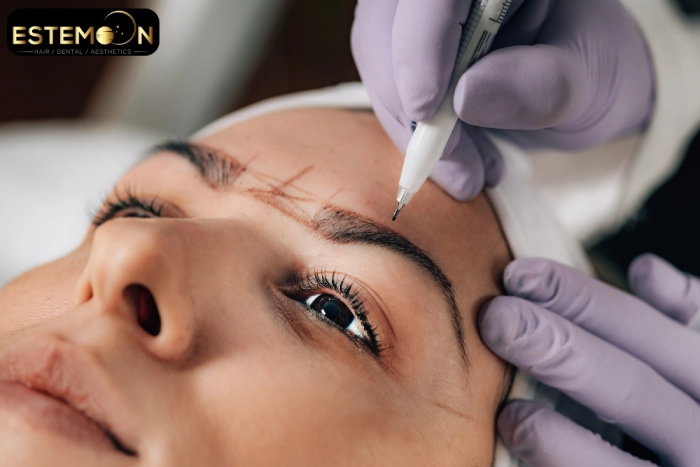
Table of Contents
Why Are My Eyebrows Thinning?
Eyebrow thinning can occur due to overplucking, hormonal imbalances, aging, nutritional deficiencies, skin conditions, or genetics. Stress and some medications can also contribute. In many cases, hair follicles become dormant or damaged, leading to patchy or thin brows.
Identifying the Cause
Understanding the cause of eyebrow loss is key to determining whether an eyebrow transplant is suitable or if alternative treatments are better. Clinics in Turkey often conduct a detailed diagnosis to ensure the treatment plan addresses the underlying issue.
What Is an Eyebrow Hair Transplant?
An eyebrow hair transplant is a minimally invasive procedure that restores hair growth in sparse or thinning eyebrow areas. The transplanted hairs grow like natural eyebrow hair, matching the texture, color, and direction of the surrounding brows.
Natural-Looking Results
The procedure recreates the natural curve and direction of eyebrow hair growth. When performed in Turkey, the focus is on achieving symmetry and realistic density. Patients often request shapes based on personal preference, cultural trends, or photos.
What Causes Eyebrow Hair Loss?
Several factors can lead to eyebrow hair loss:
- Overplucking or waxing
- Thyroid dysfunction
- Skin conditions like alopecia areata
- Scarring or injury
- Nutritional deficiencies
Temporary vs. Permanent Loss
Determining whether the loss is temporary or permanent helps tailor the best restoration plan. In permanent cases, a transplant may offer the most lasting and natural-looking solution.
What Are the Relevant Anatomy and Aesthetic Goals?
Understanding the anatomy of the eyebrow ensures that the transplant mimics natural growth. Aesthetic goals depend on the patient’s facial features, gender, and personal preferences. The placement of the eyebrow’s head, arch, and tail is tailored to each individual’s bone structure.
Shape and Symmetry
Doctors in Turkey use facial analysis to design balanced and tailored eyebrow shapes for each patient. Photos and facial measurements are often used as guides to ensure a harmonious outcome.
Does Eyebrow Hair Transplant Procedure Really Work in Turkey?
Yes, eyebrow transplants performed in Turkey have high success rates due to advanced techniques and skilled surgeons. Patients enjoy natural results that last for years. Most clinics report over 90% graft survival rate.
Global Destination
Turkey has become a trusted destination for medical tourism due to its quality of care, affordability, and modern clinics. Many patients travel from Europe, the Middle East, and North America for cosmetic procedures.
What Can I Expect During Eyebrow Restoration?
You can expect a personalized treatment plan, local anesthesia, and a comfortable procedure. Most sessions last 2–4 hours depending on the number of grafts. The staff ensures your comfort throughout the entire process.
Aftercare and Healing
Redness and slight swelling may occur but subside in a few days. Patients receive aftercare kits and detailed recovery instructions. Follow-up consultations help monitor progress and results.
Free Consultation
Eyebrow Transplant Turkey Photos
Before and After
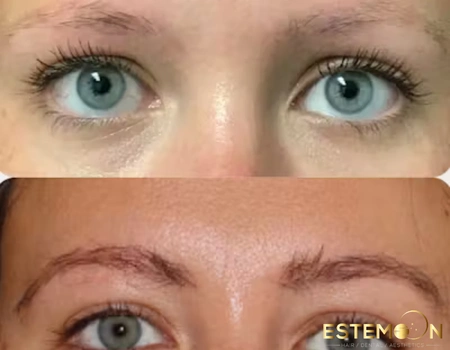
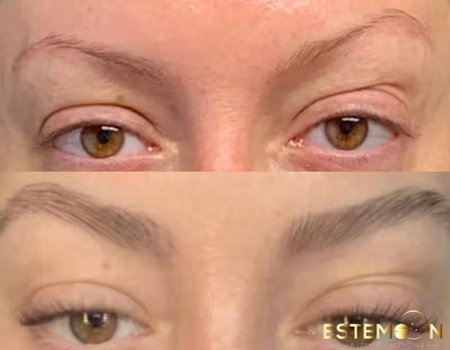

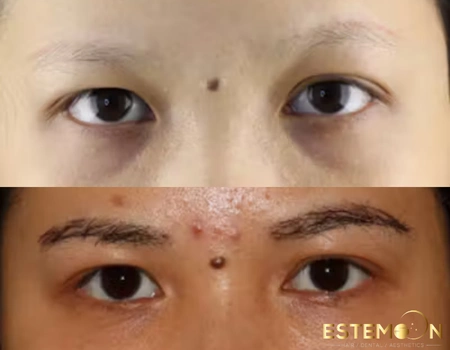
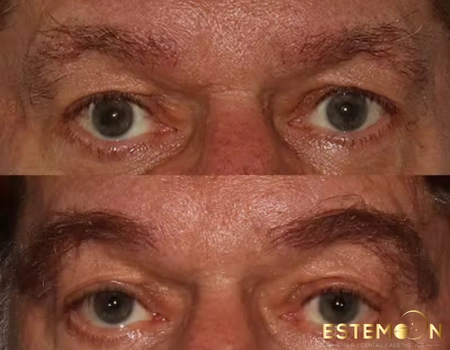
Donor Hairs for Eyebrow Transplantation
The donor hairs are usually taken from behind the ears or the lower scalp because the texture and growth pattern closely match eyebrow hair. These areas offer thin, straight hairs which are ideal for eyebrows.
Matching Hair Texture
Surgeons in Turkey are trained to select the best donor hair to ensure a natural appearance. Careful matching of hair thickness, color, and curl pattern is vital for seamless integration.
What are FUE and the Strip Method for Eyebrow Restoration
FUE involves extracting individual follicles with a micro-punch tool. The strip method (FUT) removes a strip of scalp to harvest grafts. FUE is less invasive and leaves minimal scarring.
Which One is Better?
FUE is preferred for eyebrow transplants because it causes less scarring and offers more precise control. It also allows the surgeon to implant one hair at a time, which is essential for fine eyebrow design.
Who Is a Good Candidate for an Eyebrow Transplant?
Good candidates include those with thinning eyebrows, scars, or congenital hair loss, and those who are healthy with a sufficient donor area. Patients should also have realistic expectations about the results.
Eligibility Criteria
- Non-smokers
- No active skin conditions
- Realistic expectations Consultations in Turkey include scalp assessments and medical history reviews. Patients are advised on the best method for long-term success.
How to Prepare for an Eyebrow Transplant?
Patients should avoid smoking, alcohol, and blood-thinning medications for at least a week prior. Hydration and a healthy diet are also encouraged. Avoid using any topical treatments or makeup on the brow area.
Pre-Surgery Checklist
- Avoid caffeine
- Don’t pluck or wax
- Wash face with mild soap
- Arrange transportation after surgery Following these steps helps prevent complications and supports a smooth recovery.
What to Expect on the Day of the Procedure?
The procedure is performed under local anesthesia. Patients remain awake but comfortable. The surgery includes design mapping, extraction, and implantation. Most clinics offer a calm environment to reduce anxiety.
Clinic Experience
Clinics in Turkey provide a relaxing environment with professional staff and modern equipment. You’ll be briefed thoroughly before and after the surgery.
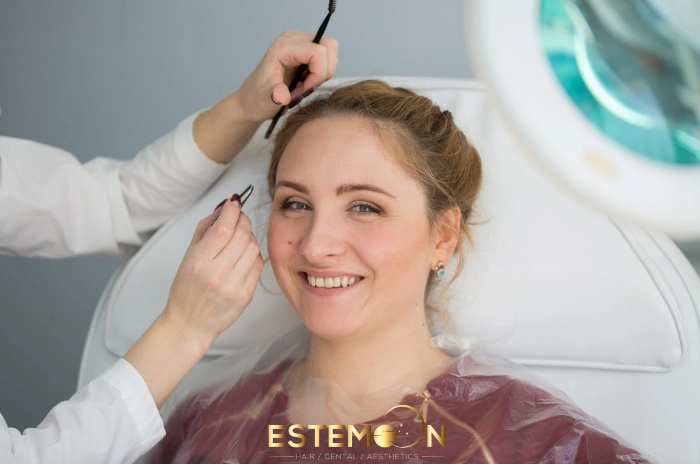
Is an Eyebrow Transplant Painful?
Most patients report minimal discomfort during the procedure. Local anesthesia numbs the area, and pain is managed with post-op medications. There may be mild soreness, which resolves in 1–2 days.
Comfort and Care
Clinics prioritize patient comfort and offer guidance at every stage. Most patients are back to light activities the same day.
Are the Results of an Eyebrow Hair Transplant Procedure Permanent?
Yes, transplanted hairs are permanent and grow just like natural eyebrow hair. They may require occasional trimming. Results continue to improve over the first year.
Long-Term Maintenance
The results are natural and durable, with most patients needing no further treatment. Annual check-ins may be recommended by some clinics.
What Is the Recovery From Eyebrow Transplant?
Most patients recover in 5–7 days. Scabbing and redness subside quickly. New hair growth begins around 3–4 months. By month 6, results become more noticeable.
Healing Timeline
- Day 1–3: Mild swelling
- Day 4–7: Scabs fall off
- Month 3: Growth starts
- Month 9–12: Full results It’s important to avoid makeup, sun exposure, and scratching during healing.
What Are the Risks and Complications of Eyebrow Transplant?
Complications are rare but may include infection, swelling, poor graft survival, or unnatural growth direction. Selecting a skilled surgeon reduces the likelihood of these issues.
Prevention
Choosing an experienced Turkish clinic minimizes risks. Follow-up care is essential. Antibiotics and soothing creams are often prescribed.
Does an Eyebrow Transplant Leave Scars?
FUE leaves tiny dot scars that are virtually invisible. FUT may leave a linear scar but is rarely used for eyebrows due to the delicate nature of the brow area.
Scar Minimization
Turkish surgeons use refined tools to keep scarring minimal. After a few months, any minor marks fade significantly.
What Are the Contraindications for Eyebrow Transplant?
Not suitable for patients with severe skin disorders, uncontrolled diabetes, or unrealistic expectations. Some autoimmune diseases may also be a factor.
Candidacy Evaluation
Medical screening is part of the initial consultation to ensure safety. Blood tests and skin assessments may be performed.
What Are the Alternatives to Eyebrow Transplant?
Alternatives include:
- Eyebrow microblading
- Topical treatments like minoxidil
- Cosmetic tattooing These are less permanent but may be suitable for some. They can also be combined with transplant surgery in some cases.
How Long Will It Take To See The Results Of My Eyebrow Restoration?
Results start to appear after 3 months. Full results are visible within 9 to 12 months. Regular follow-up helps track the outcome.
Patience Pays
Shedding is normal at first. Regrowth happens gradually but leads to lasting improvement. You may begin shaping your brows after 6 months.

What Is the Cost of an Eyebrow Transplant in Albania?
While this blog focuses on Turkey, Albania also offers eyebrow transplants at €1,200–€1,800. In Turkey, the cost typically ranges from €1,500 to €2,000 depending on grafts and clinic reputation.
What’s Included?
- Surgery
- Consultation
- Aftercare kit
- Hotel and transfer (in many clinics) Turkey is considered a better choice by many for its infrastructure and experience.
How Can I Care for my Eyebrows as they Begin to Regrow?
Use gentle cleansers and follow clinic aftercare instructions. Avoid touching or scratching the area. Keep the area moisturized if prescribed.
Care Tips
- Use prescribed ointments
- Avoid makeup for 2 weeks
- Protect from sun exposure
- Sleep on your back to avoid pressure on brows Proper aftercare can significantly improve results.
What Are the Benefits of an Eyebrow Transplantation?
- Permanent results
- Natural appearance
- Improved facial balance
- Boost in self-confidence
Why It’s Worth It
Eyebrow transplants offer long-lasting, low-maintenance solutions to hair loss. They provide emotional and aesthetic benefits.
Why Do People Get an Eyebrow Hair Transplant?
People seek eyebrow transplants due to genetics, trauma, overplucking, or cosmetic preference. It’s a personal decision that can enhance appearance and self-esteem.
Motivations
Whether for beauty, balance, or confidence, eyebrow transplants offer transformative results. Men and women alike opt for the procedure to feel more comfortable with their looks.
Your Consultation for an Eyebrow Transplant in Turkey
Your journey starts with a consultation including facial analysis, donor evaluation, and a customized treatment plan. Most Turkish clinics offer online assessments for international patients.
What to Expect
- Discuss goals and expectations
- Review medical history
- Receive a price quote and travel plan Consultations ensure personalized care and predictable outcomes. Most patients feel reassured and excited after their first meeting with the clinic team.
FAQs About Eyebrow Hair Transplant in Turkey
What is an eyebrow transplant and how does it work?
An eyebrow transplant is a procedure where hair follicles from your scalp are implanted into thinning or sparse brow areas to restore natural density and shape.
Why choose Turkey for an eyebrow transplant?
Turkey is a leading destination for eyebrow transplants thanks to its experienced surgeons, affordable pricing, and high patient satisfaction rates.
How much does an eyebrow transplant cost in Turkey?
The average cost ranges from €1,500 to €2,000, often including the procedure, consultation, hotel, and transfers in a medical tourism package.
Is an eyebrow transplant painful?
No. The procedure is performed under local anesthesia, so discomfort is minimal. Most patients experience only mild swelling or redness afterward.
How long does it take to see results from an eyebrow transplant?
New hair begins to grow after 3–4 months, with full, permanent results visible between 9 to 12 months after the procedure.
Are the results of an eyebrow transplant permanent?
Yes. The transplanted hairs continue to grow naturally for life, though occasional trimming may be needed to maintain shape and length.
